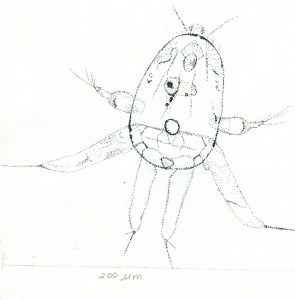Bay Shore Crab
By: V. Sed
Hemigrapsus oregonensis
Nauplius Stage
Description
Nauplius is the post-embryonic stage for most crustaceans. Nauplii are clear save for a slightly orange blotch in the body. It’s characterized by three appendages; antennae which are used for swimming, antennaes, and mandibles.  The body features a cephalic shield as well, a series of anterior cephalic somites (body segments) eventually turning into a carapace. (Ferrari, 2013).
The body features a cephalic shield as well, a series of anterior cephalic somites (body segments) eventually turning into a carapace. (Ferrari, 2013).
The nauplius goes through a series of molts before becoming an adult crustacean. This process can take anywhere from 8 to 13 weeks. As the nauplius molts, limb buds, which are lobe-like structures, are added to the posterior. Eventually the buds transform into a limb with each successive molting (Ferrari, et al. 2011). A nauplius also contains one simple eye, or naupliar eye, allowing the organism to detect light. This eye typically degenerates as the nauplius evolves into an adult crustacean.
Adult form
Description
Once the larva has transformed into an adult, the Hemigrapsus oregonensis resides in areas like open mudflats. Hemigrapsus oregonensis, often called a Bay Shore Crab, is part of the Grapsidae family. It can be identified by the yellow-green square carapace and eyes. Juveniles are typically white or mottled in color. In males the carapace can measure up to 35 mm while females are smaller at about 29 mm.
Ecology
They are a common species of crab being found along the coasts of Alaska down to California in intertidal zones. Due to being a more proficient osmoregulator than other crab species, it’s often found in estuaries. Unlike other crab species, H. oregonensis is able to withstand hypoxic conditions. Hemigrapsus oregonensis feeds at night, primarily on diatoms and seaweeds, especially Ulva and other similar green algae.
Reproduction
Females, depending on size, can produce 400-36,000 eggs a year. Egg bearing females can be seen from February to September with eggs hatching in May to July. Some females bear more eggs in August which hatch in September.Their high productive rate is useful when dealing with predators, which include shorebirds and Carcinus maenas. By burrowing holes H. Oregonensis hides itself from predatory birds. C. maenas, an invasive species from Europe, however has been able to establish populations throughout North America causing H. oregonensis numbers to fall.
Human connection
Many people are unaware of the importance the ocean plays in our lives. It provides us with not only food, but half our oxygen as well. Allowing humans to connect with marine life can help give them a better understanding of its role and promote stewardship. But how can we connect with something so alien? My animation shows the movement of a nauplii, an alien-like organism, which becomes an adult crab towards the end through a “poke-evolution”. Every kid growing up in the 90’s, and even now, is familiar with pokemon. The transformation concluding my animation allows some viewers to connect by addressing some part of their childhood.
References
Dahms, H., J. Fornshell, and B. Fornshell. “Key for the Identification of Crustacean Nauplii.” Organisms Diversity & Evolution 6.1 (2006): 47-56. Web.
“European Green Crab (Carcinus Maenas) – Aquatic Invasive Species | Washington
Department of Fish & Wildlife.” Web. 17 May 2016.
Ferrari, Frank, Hans-Uwe Dahms, Alejandro Vagelli, Ivanenko, and John Fornshell. “Early Post-Embryonic Development of Marine Chelicerates and Crustaceans with a Nauplius.” Crustaceana 84.7 (2011): 869-93. Web.
Ferrari, Frank D. “The Last Nauplius.” Crustaceana 86.5 (2013): 632-38. Web.
“Hemigrapsus Oregonensis.” Web. 16 May 2016.
“Life History of the Native Shore Crabs Hemigrapsus Oregonensis and Hemigrapsus Nudus and Their Distribution, Relative Abundance and Size Frequency Distribution at Four Sites in Yaquina Bay, Oregon.” Web. 17 May 2016.








